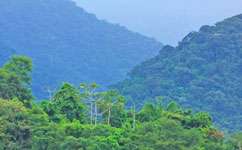Drought does long-term damage to rainforest

Recent droughts in the Amazon rainforest have effects that persist long after the rains have returned, a new study has shown.
The region was gripped by drought in 1997-8, again in 2005, and yet again in 2010. Satellite data now shows that the 2005 drought caused changes in the forest canopy that hadn't faded by the time the most recent one hit; researchers suspect these dry spells may be doing cumulative damage to the rainforest that could ultimately threaten its very existence. Already a large number of trees seem to have died across wide areas.
'It looks like we're now getting a drought around every five years, and for some areas of forest the time to recover is longer than that,' says Professor Yadvinder Malhi of the University of Oxford, a specialist in rainforest ecology and one of the authors of the paper, published in Proceedings of the National Academy of Sciences. 'So we could be looking at long-term degradation.'
The danger is that gaps start opening up in the forest, allowing light and air in to dry its interior and worsen the effects of drought. And if drought makes the forest more flammable, and there are sources of fire around – normally near human settlements – then the risk grows of large-scale fires that would transform vast swathes of the landscape. 'We could see areas of forests turning into dry, fire-prone scrub,' Malhi says.
The international team used satellite data to gauge the health of the top layer of the rainforest canopy, including the very tallest trees that tower above those around them. These trees are the most vulnerable to drought; they are exposed to more sun and wind, and their great height means it's harder for them to lift water all the way to their crowns.
Analysing the findings alongside measurements of rainfall showed that more than 70 million hectares of forest in the western Amazon were strongly affected by lack of water in the 2005 dry season. These areas showed a marked decline in canopy structure and moisture.
The QuikScat satellite effectively let the team measure the amount of water in the upper canopy. It works by firing microwaves at the Earth's surface and sensing how they are reflected back; the more the waves are scattered back to the satellite, the more moisture is present. When looking at a forest, the moisture level typically indicates the relative amount of leaves to bare branches.
After 2005, there was much less moisture in affected areas of canopy. The pre-drought situation didn't return in the next growing season – this suggests the changes weren't just a matter of leaves being shed, as they would have grown back the next year. Instead, it probably involved the death of whole trees.
'This looks like a fundamental structural change,' Malhi says. The findings seem to confirm results from earlier work involving long-term monitoring on the ground. Malhi's colleagues have been subjecting a tract of forest to artificial drought for some years, cutting off trees' supply of water by laying plastic sheeting on the ground above their roots.
They have found that bigger trees start dying off after three years of drought. In the short term the consequences aren't too bad; smaller trees get more light and water, so they grow faster. But in the long term, if too many gaps in the canopy appear too quickly the rainforest stops being a forest at all, and degrades into dry scrub.
Unfortunately QuikScat sensor stopped working in late 2009, so its results can't shed light on the aftermath of the latest drought. Researchers hope it won't be long before another satellite with similar sensors will be launched so they can continue to monitor the state of large areas of forest from space.
More information: Saatchi, S. et al. Persistent effects of a severe drought on Amazonian forest canopy. PNAS 2012 : 1204651110v1-201204651.
Journal information: Proceedings of the National Academy of Sciences
Provided by PlanetEarth Online
This story is republished courtesy of Planet Earth online, a free, companion website to the award-winning magazine Planet Earth published and funded by the Natural Environment Research Council (NERC).
















